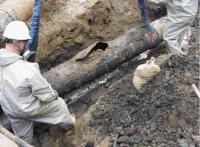-
U.S. testing radiation therapy developed in Israel
The United States will likely begin to stock anti-radiation therapy from Pluristem Therapeutics Inc., an Israeli biotech company. The company says that the therapy can also cure nearly all people exposed to the radiation effects of nuclear weapons, “dirty” bombs, or nuclear power plants.
-
-
Virginia Tech continues addressing water crisis in Flint, Michigan

Last summer, a Flint resident reached out more than 500 miles to Virginia Tech for help, after officials said the orange water flowing into residents’ homes was OK to drink. That first round of testing was a wake-up call to the nation. Virginia Tech students and discovered more than 133 times the amount of lead on average was in the water than the maximum allowed by the U.S. Environmental Protection Agency (EPA).
-
-
Ebola crisis provides framework for how to respond to outbreaks like Zika virus
As world leaders grapple with containing the Zika virus, the Ebola epidemic in West Africa provides valuable lessons for how to respond to other infectious disease epidemics, according to a just-published policy report. Rebuilding local health care infrastructures, improving capacity to respond more quickly to outbreaks and considering multiple perspectives across disciplines during decision-making processes are among the key recommendations the authors propose.
-
-
Losing the fight against antibiotic resistance

Antibiotics have been used in medicine since the 1930s, saving millions of lives. Two decades later, they were introduced into agricultural practices. A growing awareness of the antibiotic resistance crisis and continued debate over who and which activities are most responsible led to the EU calling for the use of antibiotics in non-therapeutic settings to be phased out. Tackling antibiotic resistance on only one front is a waste of time because resistant genes are freely crossing environmental, agricultural and clinical boundaries, new research has shown.
-
-
DHS response plan to the Zika virus
The Department of Health and Human Services (HHS), which includes the Centers for Disease Control and Prevention (CDC), is the U.S. government’s lead for efforts to respond to the Zika virus. As the White House announced last Monday, the president is also seeking more than $1.8 billion in supplemental funding from Congress to address the virus and our government’s response efforts.
-
-
Are tighter EPA controls on mercury pollution worth it?
Over 300,000 babies every year are born in the United States with levels of mercury that put them at risk of neurological and developmental problems. How much would you be willing to spend to reduce this number? This might seem like an abstract question, but the judgments regulators make on this question can determine whether or not a proposed regulation survives challenges in court. This was a key question addressed when the Mercury and Air Toxics Standards (MATS) was reviewed by the Supreme Court. In a 5-4 vote in June 2015, the Supreme Court held that the EPA should have considered costs when deciding to regulate mercury. Research suggests that including a larger set of health effects of high levels of mercury – namely, both IQ and heart attacks – and the impact on specific populations could lead to mercury-related benefits estimates that are orders of magnitude larger than those reported by the EPA. Regardless of the approach used to weigh advantages and disadvantages of policy, the research is now clear: the benefits of MATS are substantial.
-
-
WHO “must reform” to deal effectively with pandemics like Zika
The World Health Organization’s (WHO) emergency response capabilities are “lacking” and will put thousands of lives at risk if they are not reformed now, a UN panel, convened in the wake of the Ebola crisis, said. “This may be the last opportunity to ensure the WHO is empowered” to build an effective emergency response capacity, an advance unedited copy of the UN panel’s report warned.
-
-
Obama urges Americans not to panic, asks Congress for emergency funding

President Barack Obama has urged the American public not to panic about the Zika virus, and has asked Congress for more than $1.8 billion emergency funding to combat further infections. Speaking in an interview on CBS This Morning, Obama said: “The good news is this is not like Ebola, people don’t die of Zika — a lot of people get it and don’t even know that they have it.”
-
-
Toxic lead can stay in the body for years after exposure

The ongoing water crisis in Flint, Michigan has highlighted just how harmful lead contamination is. What you may not realize, however, is that lead exposure is a problem throughout the United States. The Centers for Disease Control and Prevention estimates that over four million households with children in the United States are exposed to elevated levels of lead. At least half a million children have blood lead levels above five micrograms per deciliter, the threshold that prompts a public health response. Because lead causes irreversible damage, making sure that people are not exposed to lead is especially important. Lead exposure in the United States has been minimized by two government actions – in 1973 and 1977 — but there is still plenty of lead out there. And those who are poor or live in the shadow of abandoned industrial sites are often at greatest risk.
-
-
Planes arriving from Zika-infected regions to be sprayed with insecticides

The U.K. government announced that planes landing in the United Kingdom from areas affected by the Zika virus will be sprayed with insecticide as part of the government’s response to the outbreak. So far there have been no Zika cases reported in the United Kingdom, but two adults in Ireland were confirmed to have been infected. Both have since fully recovered.
-
-
Florida declares state of emergency in four counties with Zika virus

Florida Governor Rick Scott has declared a state of emergency in four counties where nine residents have been diagnosed with the Zika virus. Miami-Dade in south Florida, Hillsborough in Tampa Bay, Lee County in southwest Florida, and Santa Rosa County in Florida Panhandle have all been affected under the executive order. Health officials believe, however, that the residents became sick outside the United States.
-
-
FBI launches investigation of lead poisoning of Flint’s drinking water

The FBI has launched an investigation into the contamination of drinking water in Flint, Michigan, which has left Flint children and other residents poisoned by lead. In a hearings on the Hill yesterday, lawmakers from both parties described what is happening in Flint as a “a man-made public health catastrophe.” Flint’s drinking water became contaminated with lead in April 2014 after a state-appointed emergency manager ordered city officials temporarily to switch the city’s water source from Lake Huron water treated by the Detroit Water and Sewerage Department to water from the Flint River, treated at the Flint water treatment plant. The order by the state-appointed emergency manager was part of the state’s cost-cutting measures.
-
-
In kids, even low lead levels can cause lasting harm
Until a few years ago, the federal standard for action was 10 micrograms per deciliter of blood, and in 2012 it was lowered by half in recognition of evidence showing a lower threshold of concern. But the truth is there is no known safe level of blood lead for children, and the American Academy of Pediatrics and the Centers for Disease Control and Prevention have said as much. The medical research community has documented negative impacts on children with even lower levels of lead exposure than the current 5 micrograms per deciliters standard. With that view, we might consider every child with a confirmed nonzero lead test as at-risk. Testing lead blood levels in children is simply too late. This is akin to the TSA searching for lethal weapons after the passengers have boarded the flight and the plan has taken off. Once the lead is in the bloodstream, the damage is real and lasting for these children, and the options for response are far fewer and less effective. Children living in low-income neighborhoods, children of color, and children whose families live in rental housing are statistically at the greatest risk of exposure to lead. That means the children most at risk of lead exposure also disproportionately face the effects of poverty, low-resource communities, and trauma.
-
-
Gun deaths in U.S. highest among high-income nations

New study finds that the United States, despite having only half the population of the other twenty-two high-income nations combined, accounted for 82 percent of all firearm deaths. In addition, the United State accounted for 90 percent of all women, 91 percent of children aged 0 to 14 years, and 92 percent of youth aged 15 to 24 years who are killed by firearms.
-
-
LA, Calif. file criminal charges against SoCalGas over massive methane leak

Criminal charges were filed on Tuesday against Southern California Gas, the utility company whose blown-out natural gas well forced thousands of people in the Los Angeles area to evacuate their homes. The charges claim that the company failed to report the massive leak to the authorities, as it operating license requires.Papers filed in court yesterday claim that the company allowed the release of 80,000 metric tons of methane into the atmosphere.
-
More headlines
The long view
We Ran the C.D.C.: Kennedy Is Endangering Every American’s Health
Nine former leaders of the Centers for Disease Control and Prevention (CDC), who served as directors or acting directors under Republican and Democratic administrations, serving under presidents from Jimmy Carter to Donald Trrump, argue that HHS Secretary Roert F. Kennedy Jr. poses a clear and present danger to the health of Americans. He has placed anti-vaxxers and conspiracy theorists at top HHS positions, and he appears to be guided by a hostility to science and a belief in bizarre, unscientific approaches to public health.
